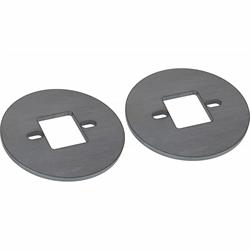Prepping Control Arms for Coil-Overs - 1967 Chevelle
As promised, this article dovetails off the end of the control arm article. Since these two projects were done concurrently, now seems like a good time to cover the process of prepping these arms for use with coil-overs.
Normally the front shock absorber mounts from below the control arm with bolts that tread into a speed nut or welded nut (in this case) on the lower control arm. When you change that shock absorbers work load to also include supporting the weight of the vehicle, which requires that you place that load on top of the control arm in order for the load to transfer to the arm via direct contact rather than through the tensile load on the bolts. Below, I’ll detail the steps that I took to ensure this conversion would perform and last.
I drilled out the old nuts as best as I could with a step drill, ensuring that I didn’t open up the holes in the control arm any larger than the newly required 3/8”. Then I was able to break away most of the remaining nuts with lineman’s pliers to leave just the welds to be ground. I ground and smoothed away the welds with a cutoff wheel on my angle grinder.
Since the new hardware supplied with the QA1 coilovers upgraded these fasteners to 3/8” fine thread, I drilled those holes to the new dimension after grinding was complete.
This led me to a new concern. The way that the “top hat” for the lower shock mount is designed leaves a large, unsupported area directly under where the cross-bar of the coil-over will rest. Given the punishment that a big block, plus air conditioning, plus aggressive driving will give, I decided to try and come up with a way to beef this area up.
What I came up with is this. Now sold under part #910-3610, this reinforcement plate sandwiches between the coil-over lower mount and the mounting pad on the arm. This plate takes the load and spreads it across the entire top-hat area and being over-sized also provides a block-off plate for the now unused coil spring pocket. Which may otherwise collect debris.
With prototype parts in hand I assembled the coil-overs per the instructions provided by QA1. I opted to add the Torrington bearing kit as well to aid in future ride height adjustments.
During installation I noted that the increased thickness of the plates caused the bolts not to protrude far enough into the nylock nuts to actually engage the locking ring. I chose to source new bolts that are .25” longer to ensure good engagement.
Something else that I’ve found essential to happy life with coil-overs, is the liberal application of anti-seize to the aluminum threads on the body of the shock. This will pay dividends down the road when you want to make adjustments to your setup.
All in all, this was a very productive upgrade and went a long way toward my goal of getting the car back down on the ground and on four wheels again.




